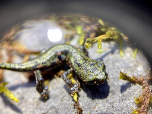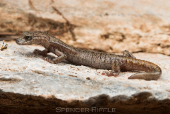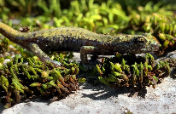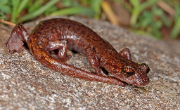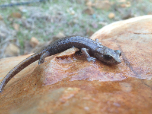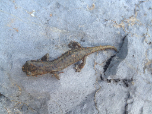Samwel Shasta Salamander (Hydromantes samweli)
Description: Adults measure 1 3/4 to 2 1/2 inches long from snout to vent length, and from 3 to 4 1/3 inches in total length. A small stocky salamander with a short tail, webbed feet, a flattened body, and a very long mushroom-like tongue capable of extending out up to 2.4 inches from the front of the mouth. 13 costal grooves, and nasolabial grooves. Not as adapted for crack dwelling as other Hydromantes species with less toe webbing and the body is not as flattened. Dark reddish brown above, mottled with grayish green to tan specks, with some yellow on the tail. Venter is grayish.
Habitat: This species occurs in limestone dominated habitats within a mosaic of hardwood, conifer, and hardwood-conifer forest with chaparral inclusions. Individuals extensively utilize caves and limestone fissures, and are often found under rocks and other surface cover. The area in which this species occurs experiences cool, wet winters with snow falling on the higher slopes, and hot, dry summers. Summers are long, with 5 to 7 months of little to no rainfall. During this period, underground retreats are essential to this species. This species is discontinuously distributed, and occurs in generally small patches of habitat.
Range: It is found in a fairly small area around the north-central and northwest sides of Shasta Lake, but possibly extending 20 km further to the west.
Found in these States:
CA
Diet: Probably feeds on insects and other small invertebrates.
Reproduction: This species breeds by direct development, as with congeners.
Status: This species has a very restricted range with an extent of occurrence of 956 km2. It occurs mostly on federally protected land, and its population is believed to be stable at present, however, there is a current proposal to raise the Shasta Dam and the associated construction could present a future threat to the habitat of this species. In addition, climate change is an increasing threat in this region that could result in decline in the quality of habitat in the future. Lastly, if disease (Bsal) was introduced within its range it could cause significant declines in the population. All of these future threats have the potential to drive this species to Endangered in a very short period of time hence it is currently listed as Near Threatened under criterion D2.
Taxonomy: It was previously thought to be a population of the Shasta salamander (H. shastae) and is not physically distinguishable, but a 2018 phylogenetic study found it to be a genetically distinct species. It is named after its type locality, Samwel Cave, which originates from Sa-Wal, the Wintu name for grizzly bear.
»» Kingdom: Animalia - Animals
»» Phylum: Chordata - Chordates
»» Subphylum: Vertebrata - Vertebrates
»» Class: Amphibia - (Amphibians)
»» Order: Caudata - Salamanders
»» Family: Plethodontidae - Lungless Salamanders
»» Genus: Hydromantes
»» Species: Hydromantes samweli - Samwel Shasta Salamander
This article uses material from the Wikipedia article "Samwel Shasta Salamander", which is released under the Creative Commons Attribution-Share-Alike License 3.0. Content may have been omitted from the original, but no content has been changed or extended.
|



